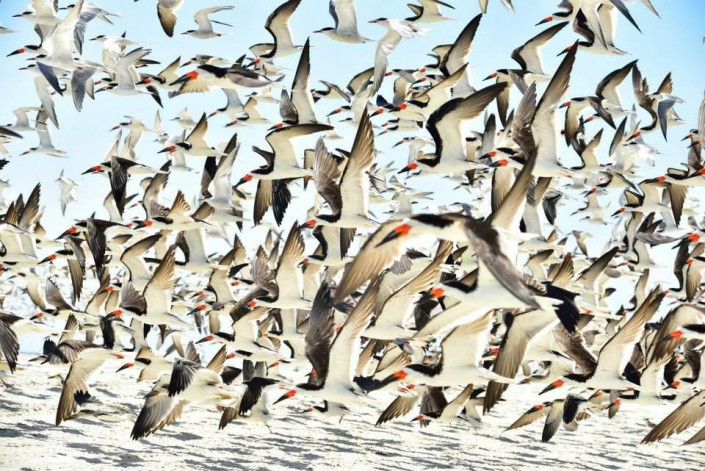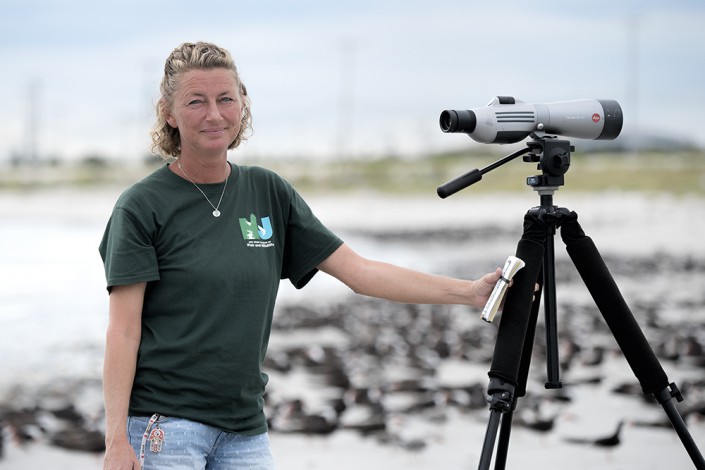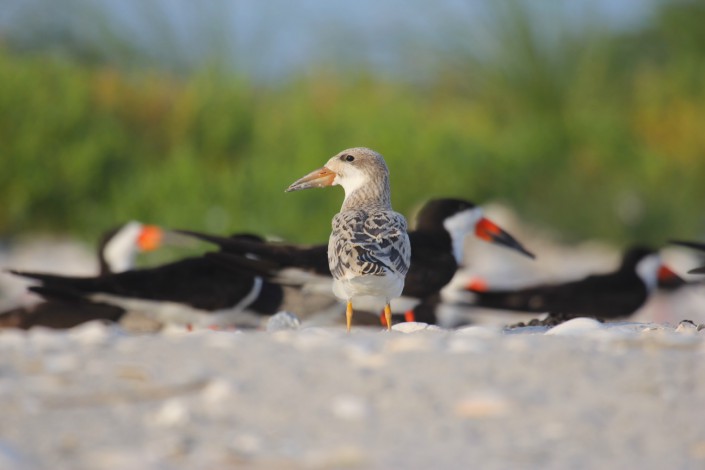A Tale of Two Colonies
An Insider’s View of New Jersey’s Skimmer Nation
by Laura Hardy and Pam Prichard, Beach Nesting Bird Field Technicians

by Laura Hardy:
New Jersey’s largest breeding colony of black skimmers is an uncommon joy. I’ve stood many hours this season totally bemused by these boisterous barking birds. I’m thrilled when, en masse, the colony takes flight right over my head, in the purest National Geographic moment I might ever experience. However, as the colony’s primary monitor, my job isn’t to be dazzled by the birds – those candy-corn bills, the funny barking calls, the gorgeous choreography of their flight – instead it’s to conduct biweekly counts of the birds in order to monitor the colony’s size and productivity.
Every summer for the past several years, about 1,000 black skimmer pairs have nested on the little stretch of beach known as Seaview Harbor Marina; nearly 2,600 birds at its peak this season. Black skimmers, plus least and common terns, gather there in an incredibly noisy colony. Piping plovers and American oystercatchers nest on site also.

Have you ever tried to count thousands of raucous swirling birds while being dive-bombed by hot-tempered terns? The first time I tried, I didn’t know how or where to start. I started over at least eleven times that first day just to be sure I was right. Even still, my boss saw my number and said I had probably underestimated the size of the colony. Argh!
During the next count, I briefly considered multiplying my tally by some random number like 1.4297363 in order to accurately reflect the number of birds my boss thought I should be seeing. Instead, he bought me a step stool that made seeing the birds much easier. Nesting adults had become obscured by growing vegetation in the colony — but the stool made me even more of a target for the dive-bombing terns.
During the next couple of count periods, as the colony continued to grow, I worried that I was compensating for the natural tendency to underestimate by over-estimating. The last two or three counts, with the colony at its peak and chicks all over the beach, I thought for sure I was hallucinating – there simply could not be that many birds!
Finally, all kidding aside, I’ve come to believe there is some art to the task but, for the most part, I approach counting as methodically as possible. I count individual birds in the colony, by species, and then check my accuracy by counting in groups of five or ten birds, then 50 or 100. It takes some practice to be able to visualize what 100 or 500 birds look like, but it’s useful to be able to estimate the number of birds you see in a quick glance because the colony will flush any number of times during a typical count day.
Counting is further complicated by the need to estimate the number of birds on nests, and then later in the season, the number of chicks that are near-fledging or already fledged (able to fly). I also had the opportunity to test my accuracy against aerial photos of the colony and was pleasantly surprised with the accuracy of my on-the-ground count.
All of this counting and recounting is important because it allows us to measure the reproductive success of the colony. Black skimmers, and all of our beach-nesting birds, put a huge amount of effort into breeding and the numbers show the Seaview colony had a very productive season with a minimum of 1,000 fledglings so far, but likely as many as 1,500… and still counting!

by Pam Prichard:
To those of us that monitor beach nesting birds in Monmouth County, black skimmers were known only by a simple drawing on our AREA CLOSED signs that are attached to the fencing erected each spring to help protect endangered piping plovers and least terns. This season, however, held an exciting surprise as we witnessed the formation of a significant new back skimmer colony in New Jersey. Sandwiched between two immensely popular and busy beaches (Belmar and Avon), the portion of Belmar’s beach along the Shark River Inlet played host to hundreds of least terns, common terns, a pair of American oystercatchers – and our very own celebrity skimmers.
The skimmers quietly started arriving in mid-June, a few at a time. Were they just hanging out? Or were they actually going to start laying eggs? As more appeared day by day before our incredulous eyes, the reality became undeniable. The skimmers were nesting, for the first time since this habitat was set aside to be “natural.” And wow, what a colony it became, with nearly 200 adult Skimmers!
The nests were somewhat hidden among sea rocket and seaside goldenrod in the middle of the site, and didn’t attract too much attention at first. It wasn’t until the chicks began to hatch and grow that the real show began. The adults brought the chicks out to the front of the beach and their fan base began to form.

In the early mornings, the bird paparazzi (photographers) would arrive. Word had spread about the appearance of these strange looking, charismatic, comical yet majestic, and very photogenic birds. Everyone wanted a photo of adults skimming the water for fish or the tide line for crustaceans. They wanted to capture that moment when a chick was being brooded or fed. When the colony would all fly up at once, swooping and circling, making their distinctive barking puppy sounds, it was a stunning sight to see and hear. And let’s not forget the distinctive way they kick up sand, or flop down, as if their bill was just too heavy to hold up for one second longer. More than one person asked me if they were dead, and I admit, I would often hold my breath, until I thankfully saw some movement!
In addition to the steady stream of photographers, beachgoers visited the site every day to check on the busy colony and find out the latest news. People gathered in front of the fence to watch, enraptured, and to talk about what was going on. They returned day after day, bringing friends, and forging new friendships. Children looked through the scope to see the littlest of chicks, camouflaged so well in the sand. Many people told me they had never seen anything like this in Belmar. The black skimmers were the talk of the town!
A resident told me of growing up and playing behind a truck as it sprayed DDT. He said it has been wonderful to see so many species rebound in New Jersey, species like the osprey, eagle and now black skimmers right in Belmar. As of this date (they are not quite done yet), we have had nearly 150 skimmer chicks make it to the fledgling (flying) stage, no small accomplishment. The beach loving public here truly embraced the black skimmers, giving us lots of positive feedback. We all look forward to the return of our “celebrities” again next year.
Learn more:
- Conserve Wildlife Foundation’s Online Field Guide: Black Skimmer
- Conserve Wildlife Foundation’s Beach Nesting Bird Project
Laura Hardy and Pam Prichard are Beach Nesting Bird Field Technicians working in partnership with Conserve Wildlife Foundation of New Jersey.
Discover more from Conserve Wildlife Foundation of NJ
Subscribe to get the latest posts sent to your email.
Leave a Comment
Excellent job!! It’s really great to see the public interest in the birds too, rather than the usual disagreement over closed areas of the beach. Keep up the great work, especially with keeping the public informed!
This is a great program. Laura and Donna doing wonderful work! I hope it will continue. Paul Shaw
Sorry for not mentioning Pam in last post….
Fantastic work you are doing! I love to hear these barkers as they fly by — they are a true sign that we are taking care of our beach nesting habitats. Thanks for the great work and service to these wonderful birds!
Comments are closed.